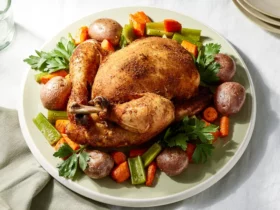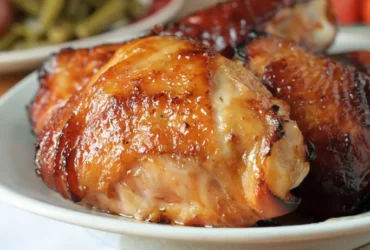Ingredients
Selecting the Right Chicken Thighs
When it comes to selecting the right chicken thighs for grilling, there are several factors to consider to ensure you get the best results.
The first thing to look for is the freshness and quality of the chicken thighs. Freshness can be determined by checking the “sell by” or “use by” date on the package, as well as giving them a sniff to check for any off-odors. The skin should be plump and moist, and the flesh should be pale pink in color.
Next, consider the size of the chicken thighs. For grilling, you’ll want to use thighs that are about 3-4 ounces each. These will cook more evenly and quickly than larger or smaller pieces of meat.
The type of bone structure is also important when selecting chicken thighs for grilling. You can choose between bone-in or boneless thighs. Bone-in thighs will be more flavorful, as the bone marrow adds a rich depth to the meat. However, they may take longer to cook than boneless thighs. Boneless thighs, on the other hand, are quicker to cook but may not have as much flavor.
Another consideration is the level of fat in the chicken thighs. For grilling, you’ll want thighs with a moderate amount of fat to keep them juicy and moist throughout the cooking process. Thighs that are too lean will dry out quickly on the grill.
In addition to these factors, it’s also worth considering the origin of the chicken. Organic or free-range chickens may have more favorable fat profiles and be less likely to contain antibiotics than conventionally raised birds.
Finally, look for thighs that are labeled as “air-chilled” or “wet-aged.” These chickens will typically have a better texture and flavor than those that are conventionally chilled or dry-aged.
Bonein chicken thighs with skin on are ideal for grilling, as they retain moisture and flavor.
Bone-in chicken thighs with the skin on are an excellent choice for grilling because they have a natural advantage when it comes to retaining moisture and flavor.
The bone acts as an insulator, helping to keep the meat juicy and tender even after prolonged exposure to heat. Meanwhile, the skin adds a crispy texture and rich, caramelized flavor that’s impossible to replicate with boneless chicken thighs.
When you grill bone-in chicken thighs, the fat content in the meat helps to baste itself with its own juices, ensuring that every bite is full of flavor and moisture. This makes for a far more enjoyable eating experience compared to dry and overcooked boneless chicken breasts.
In addition to their inherent advantages, bone-in chicken thighs also have the ability to absorb flavors from marinades and seasonings like no other type of poultry. The exposed surface area allows for maximum penetration of aromatics and spices, which are then evenly distributed throughout the meat during cooking.
Finally, bone-in chicken thighs with skin on offer a more satisfying presentation than their boneless counterparts. The intact skin creates a visually appealing char that’s perfect for grilling enthusiasts who want to impress family and friends with their outdoor cooking skills.
In summary, if you’re serious about achieving the ultimate grilled chicken thighs experience, make sure to use bone-in chicken thighs with the skin on. Your taste buds (and your guests) will thank you!
Aim for thighs that are roughly 11.5 pounds each to ensure even cooking.
To achieve perfect grilled chicken thighs, it’s crucial to select ingredients that will enhance their flavor and texture. Here are some key considerations:
- Chicken Thighs: As mentioned earlier, aim for thighs that are roughly 11.5 pounds each to ensure even cooking.
- Seasonings: A blend of salt, pepper, and your favorite herbs will elevate the flavor of the chicken. Popular options include paprika, garlic powder, onion powder, dried oregano, and thyme.
- Olive Oil: This is a staple for grilled meats, providing a rich, savory flavor and helping to prevent sticking. Use high-quality extra virgin olive oil for the best results.
- Acidity: A squeeze of fresh lemon juice or vinegar (such as apple cider or balsamic) will add brightness and balance out the flavors.
- Aromatics: Consider adding some sliced onions, bell peppers, or mushrooms to the grill alongside the chicken for added flavor and texture.
Remember to always use fresh, high-quality ingredients to ensure the best results. The type and quality of your ingredients will directly impact the flavor and presentation of your grilled chicken thighs.
Preparation
Marinades and Seasonings
- To achieve perfectly grilled chicken thighs, preparation is key to ensuring the meat remains moist and flavorful throughout the cooking process.
- The first step involves preparing the chicken thighs by removing any excess fat or skin, which can lead to flare-ups on the grill.
- Next, pat the chicken dry with paper towels to help the seasonings adhere better.
- Avoid over-handling the meat, as this can cause it to become tough and chewy.
Now, let’s discuss marinades – a crucial component in enhancing the flavor of grilled chicken thighs. A marinade is a mixture of ingredients that helps to tenderize, add flavor, and protect the meat from drying out during the grilling process.
Some common components found in marinades include:
- Oils (such as olive or avocado oil) – help to keep the chicken moist and aid in even cooking
- Acids (like lemon juice or vinegar) – break down proteins, making the meat more tender
- Spices and herbs – add flavor and aroma to the dish
- Sugars – contribute to browning and add sweetness to balance out acidity
When creating a marinade, it’s essential to strike a balance between the strength of flavors and the length of time the chicken is left to marinate. A general rule of thumb is to allow 2-24 hours for the marinade to work its magic.
Now that we’ve covered marinades, let’s explore some common seasoning options:
- Mixtures of paprika, garlic powder, and onion powder provide a smoky flavor
- Curry powder or garam masala add warmth and aromatic depth
- Italian seasoning blends typically include basil, oregano, and thyme for a classic Mediterranean taste
- Lemon pepper is another popular choice, combining citrus with the subtle kick of black pepper
When applying seasonings, it’s crucial to remember that less is often more. Over-seasoning can be overwhelming and overpower the natural flavor of the chicken.
To get the most out of your seasoning, focus on a few key elements rather than trying to combine too many different flavors.
The final step in preparing grilled chicken thighs involves creating a flavorful sauce or glaze to brush over the meat during the grilling process. This can range from simple mixtures like olive oil and herbs to more complex concoctions incorporating soy sauce, honey, or Dijon mustard.
Marinate the chicken thighs in a mixture of olive oil, lemon juice, garlic, and your choice of herbs (such as thyme or rosemary) for at least 30 minutes.
To prepare delicious grilled chicken thighs, it’s essential to start with a flavorful and aromatic marinade that will infuse the meat with the right balance of flavors.
The first step in creating this marinade is to combine olive oil, lemon juice, garlic, and your choice of herbs in a bowl. Olive oil serves as a carrier for the other ingredients, while lemon juice adds a tangy flavor that helps to break down the proteins in the chicken.
Minced or crushed garlic adds depth and richness to the marinade, so be sure to use a generous amount. You can also add some grated ginger or onion to further enhance the flavor.
For this recipe, we recommend using thyme or rosemary as our herb of choice. Thyme has a slightly minty and earthy flavor that pairs well with chicken, while rosemary adds a piney and slightly bitter taste that complements the richness of the meat.
To make the marinade, combine 1/4 cup olive oil, 2 tablespoons lemon juice, 2 cloves minced garlic, and 1 sprig fresh thyme or rosemary in a bowl. Mix well to ensure that all the ingredients are fully incorporated.
Next, add your chicken thighs to a large zip-top plastic bag or a shallow dish. Pour the marinade over the chicken, turning to coat evenly. Seal the bag or cover the dish with plastic wrap, making sure that the chicken is completely submerged in the marinade.
Refrigerate the chicken for at least 30 minutes and up to several hours or even overnight. The longer it marinate, the more flavorful it will become. However, be careful not to over-marinate, as this can result in tough and chewy meat.
Alternatively, season with salt, pepper, paprika, and chili powder for a smoky flavor.
When preparing grilled chicken thighs, it’s essential to start with proper seasoning to enhance their natural flavors and create a mouthwatering dish.
To add depth and complexity to your grilled chicken thighs, consider using a combination of spices and herbs for marination or direct application before grilling.
One popular method is to season the chicken thighs with salt, pepper, paprika, and chili powder for a smoky flavor. This blend will not only add a savory taste but also contribute a subtle heat from the chili powder.
The use of salt as a seasoning can be attributed to its ability to enhance flavors and textures in food, particularly meats like chicken thighs. A moderate amount of salt can balance out sweetness and acidity present in various ingredients.
Black pepper is another staple spice commonly used for grilling, offering an unmistakable heat that complements the smoky flavor imparted by paprika and chili powder. Its aromatic properties also play a significant role in elevating the overall taste experience of your dish.
Paprika adds a distinct smokiness to grilled chicken thighs while providing a slightly sweet and earthy undertone, making it an excellent choice for achieving that perfect balance of flavors.
Lastly, chili powder brings heat without overpowering the delicate taste of chicken thighs. It’s ideal for those who want to add some excitement to their grilled meals without compromising on flavor or texture.
Incorporating these seasonings will undoubtedly elevate your grilled chicken thighs and make them more appealing to both the palate and visual senses, perfect for any gathering or special occasion.
Cooking
Grilling Techniques
The art of grilling has become an integral part of modern outdoor cooking, allowing individuals to create mouth-watering dishes while enjoying the great outdoors. Among the numerous options available for grilled meats, chicken thighs stand out as a crowd-pleaser due to their rich flavor and tender texture.
For those seeking to master the art of grilling chicken thighs, understanding various techniques is essential. The first step involves selecting the right ingredients – in this case, bone-in or boneless chicken thighs will yield distinct results. Marinating the chicken before grilling can enhance its taste, but the quality and type of marinade used can significantly impact the final product.
Preheating the grill is another critical aspect to consider. The ideal temperature for cooking chicken thighs depends on personal preference and the desired level of doneness. Cooking over high heat will result in a crispy exterior, whereas medium or low heat may lead to a more tender texture with a less charred appearance.
Grilling methods can vary depending on the equipment used – gas grills tend to offer consistent temperatures, while charcoal or wood-fired grills provide a smoky flavor. The choice between these options should be based on personal preference and the desired outcome.
Once the grill is preheated, it’s essential to prepare the chicken thighs for cooking. Patting them dry with paper towels will help create a crispy exterior by preventing moisture from interfering with the Maillard reaction – the chemical reaction responsible for the formation of new flavor compounds when food is cooked.
Applying an adequate amount of oil to both sides of the chicken thighs before grilling can help prevent sticking and promote browning. Using a brush or tongs, spread the oil evenly over the surface of the meat while ensuring not to apply too much, which could create a greasy texture.
Place the chicken thighs on the grill with sufficient space between each piece to allow for even cooking and proper air circulation. Rotating the chicken occasionally will help ensure even browning and prevent hot spots from forming on the grill.
Cooking times will vary depending on personal preference, but generally speaking, bone-in chicken thighs should be cooked until they reach an internal temperature of 165°F (74°C). Using a meat thermometer is the most accurate way to gauge the doneness of the chicken. Boneless chicken thighs typically cook faster and may require less time.
After removing the grilled chicken thighs from the heat, let them rest for a few minutes before serving. This will help redistribute juices within the meat, resulting in a more tender and flavorful final product.
In conclusion, mastering the art of grilling chicken thighs requires a combination of understanding various techniques, selecting high-quality ingredients, and experimenting with different methods to achieve personal preferences. By following these guidelines and practicing patience and persistence, anyone can become proficient in cooking delicious grilled chicken thighs that are sure to impress friends and family.
Preheat the grill to medium high heat (around 400°F).
- To achieve perfectly grilled chicken thighs, it’s essential to start with a well-preheated grill.
- Preheat the grill to medium-high heat (around 400°F), which will allow for even cooking and a nice char on the outside of the meat.
- Making sure that your grill is at the correct temperature is crucial, as it will help prevent food from sticking to the grates and promote browning.
- For those who are new to grilling, medium-high heat is an ideal setting for chicken thighs, as it provides a balance between searing and cooking through.
- The recommended temperature range of 375°F to 425°F ensures that the meat cooks evenly and prevents it from becoming too charred or burnt.
- To ensure accurate temperature control, consider investing in a grill thermometer, which will give you precise readings and help you fine-tune your grilling skills.
- Additionally, always remember to oil the grates before adding the chicken thighs, as this will prevent them from sticking and promote even cooking.
- Avoid overcrowding the grill, as this can lead to uneven cooking and decreased quality. Cook in batches if necessary, to ensure that each piece of meat has enough space to cook properly.
Place the chicken thighs on the grill, skin side down, and cook for 57 minutes or until the skin is crispy.
When it comes to cooking grilled chicken thighs, achieving that perfect balance of flavors and textures can make all the difference. The process begins with selecting the right type of chicken – bone-in, skin-on thighs are ideal for grilling as they retain moisture and develop a crispy exterior.
The next step is crucial in developing that coveted crispy skin. Place the chicken thighs on the grill, skin side down, and cook for 57 minutes or until the skin is crispy. It’s essential to ensure the heat is at a medium-low setting to prevent burning. A temperature gauge can help you monitor the internal temperature of the chicken – aim for an internal temperature of 165 degrees Fahrenheit (74 degrees Celsius) to ensure food safety.
As the chicken cooks, it’s also essential to maintain even air circulation around the grill to promote browning and crispiness. This can be achieved by adjusting the grill grates or using a fan on your grill to circulate heat evenly.
To enhance flavor, you may consider marinating the chicken thighs before grilling. A mixture of olive oil, herbs like thyme or rosemary, garlic, salt, and pepper can add depth and richness to the dish. Simply rub the marinade onto the skin side of the chicken, making sure not to overdo it as this can cause the meat to steam rather than grill.
During the final 10-15 minutes of cooking, brush the chicken with a mixture of melted butter or oil infused with aromatics like garlic or herbs. This will add an extra layer of flavor and help create that signature glaze that’s characteristic of perfectly grilled chicken thighs.
To serve, let the chicken rest for a few minutes before slicing it thinly against the grain. Garnish with fresh herbs like parsley or thyme to complete the look. Grilled chicken thighs can be enjoyed as is or paired with your favorite sides, such as roasted vegetables, a simple green salad, or creamy mashed potatoes.
The key to achieving that perfect grilled chicken thigh lies in understanding the delicate balance of flavors and textures that come together in this dish. With practice and patience, you’ll master the art of grilling chicken thighs that are both crispy on the outside and juicy within – a true delight for any food lover!
Flip the thighs over and continue cooking for an additional 1012 minutes or until the internal temperature reaches 165°F.
Cooking the chicken thighs to perfection requires a delicate balance of timing and temperature control. After flipping the thighs over, it’s essential to continue cooking them for an additional 10-12 minutes or until the internal temperature reaches 165°F.
This is a crucial step in ensuring that the chicken is cooked through without becoming overcooked or dry. The internal temperature of 165°F ensures that any bacteria present on the meat are killed, making it safe to consume.
The cooking time will vary depending on the thickness of the chicken thighs and the heat level of your grill. It’s essential to use a meat thermometer to check the internal temperature, as this is the most accurate way to determine if the chicken is cooked to a safe temperature.
It’s worth noting that the recommended internal temperature for cooked chicken is 165°F in all cases. This applies whether you’re cooking whole chickens, chicken breasts, or in this case, chicken thighs.
To ensure that your chicken thighs are cooked evenly, make sure to rotate them occasionally during the additional cooking time. This will help prevent any hot spots from forming and ensure that the meat is cooked consistently throughout.
Finally, once the internal temperature has reached 165°F, remove the chicken thighs from the grill and let them rest for a few minutes before serving. This allows the juices to redistribute within the meat, making it more tender and flavorful.
Let the chicken rest for a few minutes before serving.
To achieve the perfect grilled chicken thighs, it’s crucial to pay attention to a few key details throughout the cooking process.
The first step involves prepping your chicken thighs for grilling. Rinse each thigh under cold water, pat them dry with paper towels to remove excess moisture, and season as desired with your favorite spices or herbs.
Next, heat up a grill pan over medium-high heat or preheat an outdoor grill to around 400°F (200°C). Make sure the grates are clean and brush them with some oil to prevent sticking. If using a grill pan, add a small amount of oil to the pan as well.
Once the grill is hot, place the chicken thighs on the grates or in the grill pan. Close the lid if you’re using an outdoor grill and cook for about 5-7 minutes per side, depending on the size and thickness of your chicken.
After flipping the chicken, reduce the heat to medium-low (around 300°F/150°C) to prevent burning or overcooking. This will also help promote even cooking throughout the thighs.
When the chicken is cooked through and reaches an internal temperature of at least 165°F (74°C), remove it from the grill and place on a wire rack set over a rimmed baking sheet. Let each grilled chicken thigh rest for a few minutes before serving, allowing the juices to redistribute within the meat.
Finally, slice or serve the grilled chicken thighs as desired with your favorite sides or sauces. The resting time is crucial to ensure the meat stays tender and juicy, so be patient and let it rest for a good 5-10 minutes before slicing or serving.
- Best LeadsGorilla Alternatives for 2025 - April 22, 2025
- Best Leadzai Alternatives for 2025 - April 22, 2025
- Best LeadSwift Alternatives for 2025 - April 21, 2025















